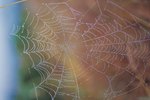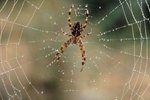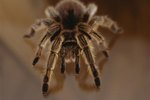
"Ladybird spider" is the common name given to a beautiful spider in a classification called Eresidae. This spider acquired the ladybird name because of its similarity in appearance to the ladybird insect, a little red beetle with black spots. This rarely seen spider is found in parts of Europe and Greenland, although other types of these velvet spiders can be found in Brazil, Asia and Africa.
Identifying Ladybird Spiders
Only mature male ladybird spiders have the classic red body with four black spots, while females are velvet black or dark grey. The males do no mature until about 2 1/2 years and only reach a size of 6 to 11 millimeters. Females mature later at 3 to 4 years and grow larger, reaching 8 to 16 millimeters. These spiders have large hairy bodies and live in burrows on the ground.
Ladybird Location
The ladybird spider is rare in northern Europe, but is seen frequently in parts of the Alps and Pyrenees. It is on the Red List in the Netherlands, Germany, Sweden and Denmark. The Red List was created by the International Union for Conservation of Nature and contains the names of species threatened with extinction. The ladybird spider was thought to be extinct in Britain until rediscovered in 1979. Conservation efforts promoted by the U.K. Biodiversity Action Plan have brought them back from near extinction in parts of England.
Ground Habitat
Ladybird spiders live on the ground in areas of dry sandy soil and build silk-lined burrows about 10 centimeters deep. Open patches of well-drained soil appeal to these ground-dwelling spiders. The soil is often nutrient-poor and acidic. Females spend their entire lives living in the burrows, while male ladybird spiders travel to the females for mating. Colonies of ladybird spiders stay close together, often never moving farther than 10 to 12 meters apart.
Plant Habitat
Heathlands are the favorite type of habitat for the ladybird spiders. A heathland is a wide open landscape dominated by plants such as heathers, gorse and heathland grasses with occasional scattered trees. Declining heathlands is the biggest threat to the survival of these spiders. Human encroachment and tree ingrowth can destroy this type of land.
Burrow Location
These spiders have poor dispersal potential, which means they do not travel over long distances to start new colonies or build new burrows. Ladybird spiders live in such tight colonies that fragmented heathlands can cause a decline of the species. A whole colony may have burrows on just one side of a sunny slope, protected from the wind by stones and heathers.
References
- ScienceDaily: Velvet Spiders Emerge from Underground in New Cybertaxonomic Monograph
- BBC Science & Nature: Ladybird Spider
- Spider and Harvestman Recording Scheme: Summary for Eresus Sandaliatus
- BBC Science & Environment: Ladybird Spider Back From Brink
- The Journal of Arachnology: Eresus Kollari (Araneae: Eresidae) Calls for Heathland Management
Photo Credits
-
Digital Vision./Digital Vision/Getty Images
Writer Bio
Based in Michigan, Keri Gardner has been writing scientific journal articles since 1998. Her articles have appeared in such journals as "Disability and Rehabilitation" and "Journal of Orthopaedic Research." She holds a Master of Science in comparative medicine and integrative biology from Michigan State University.




